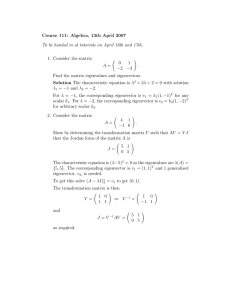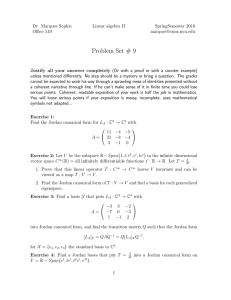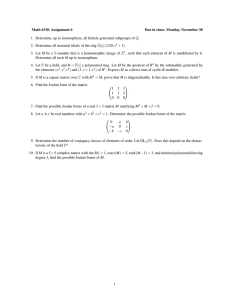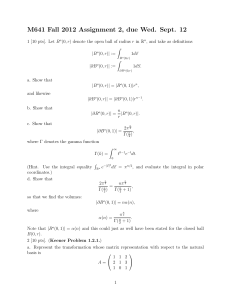How to find the Jordan canonical form of a matrix
advertisement
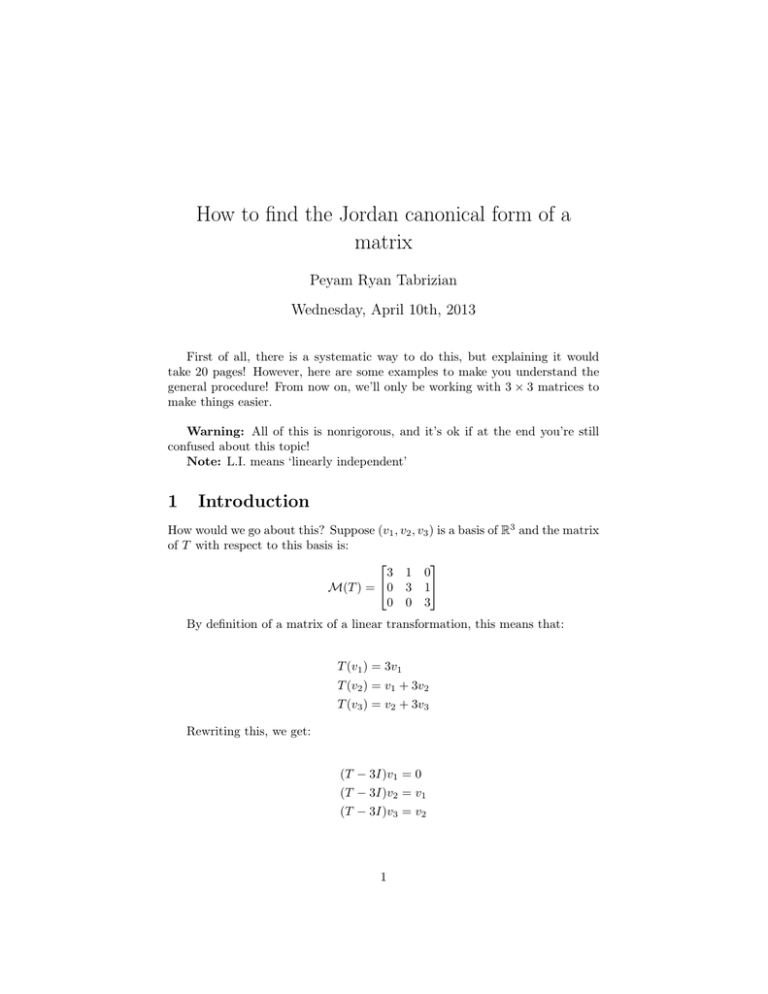
How to find the Jordan canonical form of a matrix Peyam Ryan Tabrizian Wednesday, April 10th, 2013 First of all, there is a systematic way to do this, but explaining it would take 20 pages! However, here are some examples to make you understand the general procedure! From now on, we’ll only be working with 3 × 3 matrices to make things easier. Warning: All of this is nonrigorous, and it’s ok if at the end you’re still confused about this topic! Note: L.I. means ‘linearly independent’ 1 Introduction How would we go about this? Suppose (v1 , v2 , v3 ) is a basis of R3 and the matrix of T with respect to this basis is: 3 1 0 M(T ) = 0 3 1 0 0 3 By definition of a matrix of a linear transformation, this means that: T (v1 ) = 3v1 T (v2 ) = v1 + 3v2 T (v3 ) = v2 + 3v3 Rewriting this, we get: (T − 3I)v1 = 0 (T − 3I)v2 = v1 (T − 3I)v3 = v2 1 From this example, we can guess the following strategy, which we’ll follow throughout this handout: General strategy: 1) First find all the eigenvectors of T corresponding to a certain eigenvalue! 2) The number of L.I. eigenvectors you found gives you the number of Jordan blocks (here there was only ’one’ L.I eigenvector, hence only one Jordan block) 3) Once you found that eigenvector, solve (T − λI)v = that eigenvector, and continue Let’s apply this strategy to a couple of examples to see how useful this is! 2 3 L.I. eigenvectors This is really the best-case scenario, and there isn’t much to do! 4 0 1 Example: Put A = 2 3 2 into Jordan canonical form. 1 0 4 1) If you calculate the eigenvalues, you find that there are two: λ = 5 and λ=3 2) Find the eigenspaces: 1 N ul(A − 5I) = Span 2 1 −1 0 N ul(A − 3I) = Span 1 , 0 0 1 Notice that here we have 3 = dim(R3 ) L.I. eigenvectors (more precisely, three linearly independent eigenvectors), so there’s no need to go further and search for generalized eigenvectors! If you put all three eigenvectors together, you find that a Jordan canonical basis for R3 is: 0 −1 1 2 , 1 , 0 1 0 1 2 And a Jordan canonical form for A is: 5 0 0 0 0 3 Here there are precisely 3 Jordan blocks: 5 , 3 , 3 . 0 3 0 3) Again, we already found our answer, so no need to go further! 3 2 L.I. eigenvectors 1 Example: Put A = 0 0 1 1 0 1 0 into Jordan canonical form. 1 1) Then you can check that λ = 1 is the only eigenvalue of A. 0 1 2) N ul(A − I) = Span 0 , 1 0 −1 3) Notice that since there are only two L.I. eigenvectors, this implies that A can only have the following Jordan canonical forms: 1 0 0 0 1 0 0 1 1 or 1 0 0 1 1 0 0 0 1 The reason for this is that notice that every column that has only one nonzero entry corresponds to an eigenvector of T (so here, the first and second columns of the first matrix correspond to eigenvectors, whereas for the second matrix, it’s the first and third columns). 1 Let’s focus on the first matrix 0 0 0 1 0 0 1. What this says is that: 1 Av1 = v1 Av2 = v2 Av3 = v3 + v2 That is: 3 (A − I)v1 = 0 (A − I)v2 = 0 (A − I)v3 = v2 Now here’s the ’guessing-part’. We know that v1 and v2 need to be eigen0 1 vectors, so how about let v1 = 1 and v2 = 0.1 −1 0 To find v3 , all we nee to solve is the equation (A − I)v3 = v2 , that is: 0 0 0 1 0 0 1 x 1 0 y = 0 0 z 0 Where v3 = (x, y, z). If you solve this, then you should get that the solution set is: 0 0 1 x 0 + y 1 + 0 1 −1 0 Since we’re only looking for one vector, we can set x = 0 and y = 0, and we get: 0 v3 = 0 1 So our answer is: 1 0 0 (v1 , v2 , v3 ) = 1 , 0 , 0 −1 0 1 And the corresponding Jordan canonical form is: 1 0 0 1 If 0 1 0 0 1 1 1 0 this fails, then just try v1 = 0 and v2 = 1 0 −1 4 1 which has two Jordan blocks, namely 1 and 0 1 . 1 Remark 1: If you chose the basis (v2 ,v3 , v1 ), then you would have gotten 1 1 0 the other Jordan canonical form 0 1 0 0 0 1 1 0 Remark 2: What if you chose v1 = 0 and v2 = 1 and tried to solve 0 −1 (A − I)v3 = v2 ? Then you would find that there are no solutions, which is a sign that you didn’t chose the right basis. In that case, do as I said and switch your v1 and v2 (see footnote). Of course this gets way more complicated for n × n matrices, but as I said, there is a systematic procedure, but it’s a bit complicated! 4 1 L.I. eigenvector That’s in some sense the worst-case-scenario, but it’s not as bad as the previous section because there’s basically only one way of doing this! −1 −1 0 Example: Put A = 0 −1 −2 into Jordan canonical form. 0 0 −1 1) There is only one eigenvalue λ = −1 2) 1 N ul(A − (−I)) = N ul(A + I) = Span 0 0 3) Here there is only one L.I. eigenvector, which means that there is only one Jordan canonical form of A, namely: −1 0 0 1 −1 0 0 1 −1 And looking at this matrix, it follows that v1 must be an eigenvector of A, and moreover: Av2 = −v2 + v1 , that is (A + I)v2 = v1 and Av3 = −v3 + v2 , that is (A + I)v3 = v2 . This means that: 5 1 (a) We let v1 = 0 0 (b) We solve for v2 in (A + I)v2 = v1 (c) And then solve for v3 in (A + I)v3 = v2 . Now if you solve (A + I)v2 = v1 for v2 = (x, y, z), you need to solve: 0 0 0 −1 0 0 0 x 1 −2 y = 0 0 z 0 Whose solution set is: 0 1 x 0 + −1 0 0 0 Again, for simplicity, choose x = 0, and you get that v2 = −12 0 Now if you solve (A + I)v3 = v2 for v3 = (x0 , y 0 , z 0 ), you need to solve: 0 0 0 −1 0 0 0 0 x 0 −2 y 0 = −1 0 z0 0 Whose solution set is: 0 1 x0 0 + 0 1 0 2 0 Again, for simplicity, choose x0 = 0, and you get that v3 = 0 1 2 So our answer is: 0 1 0 (v1 , v2 , v3 ) = 0 , −1 , 0 1 0 0 2 2 Notice 0 that it’s NOT ok to rescale v2 to 1, that would give you the wrong answer! 0 6 And the corresponding Jordan canonical form is: −1 0 0 1 −1 0 7 0 1 −1

